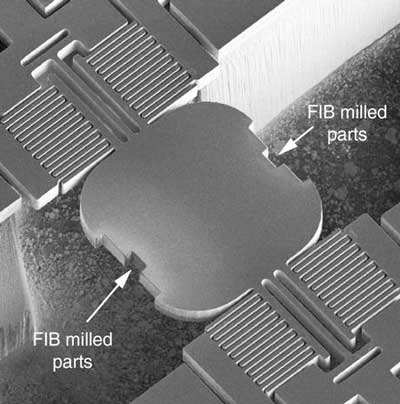| Dec 05, 2019 | |
Ultrafast x-ray optics(Nanowerk News) Scientists have demonstrated a new micro-electro-mechanical-system (MEMS) resonator. MEMS devices combine tiny electronic and mechanical components. By using this device with a hard (higher energy) X-ray, scientists can now control how long the X-ray pulses are, down to 300 picoseconds long. Picoseconds are one trillionth of a second long. |
|
| Typical synchrotrons – a type of particle accelerator – produce X-rays that are about 100 picoseconds long, but don’t have the ability to have fine control over the pulse length. | |
 |
|
| Scanning electron microscopy image of a micro-mechanical X-ray mirror after removing mass on either side by focused ion beam (FIB) milling. Removing mass reduces its moment of inertia and increases its resonant frequency. (© Nature Communications) | |
| Hard X-rays have played an important role in figuring out the structure and function of materials. However, to better understand energy conversion, storage, transmission, and use, scientists need to completely map the structure and behavior of many materials. To do so, they need X-ray probes where they can precisely control both the pulse timing and resolution. | |
| Current synchrotrons can only produce X-ray pulses at very specific speeds. These new X-ray optics can, for the first time, allow scientists to control timing of the pulses down to 300 picoseconds. Because the technique doesn’t involve the X-ray’s storage-ring components, it can be incorporated into any existing beamline. | |
| At present, synchrotron-based X-ray sources are well suited for revealing the spatiotemporal evolution of mesoscopic details in materials. | |
| However, temporal resolution is generally limited by the X-ray pulse duration, in the range of tens to hundreds of picoseconds, and by the pulse periodicity. | |
| Attaining such ultrafast time scales requires complex and costly modification of the storage ring at the expense of other source characteristics, such as intensity and brightness. | |
| In this work (Nature Communications, "Ultrafast Photonic Micro-Systems to Manipulate Hard X-rays at 300 Picoseconds"), a unique MEMS-based X-ray dynamic optics system was created using nanofabrication capabilities at the CNM. | |
| The scientists achieved the ultrafast X-ray optics by matching the MEMS resonator frequency to the storage-ring frequency, without modifying any storage-ring components. The optics system then was demonstrated at APS beamline 7-IDC to control and manipulate hard X-ray pulses significantly below one nanosecond, down to 300 picoseconds. | |
| With this exceptional time scale, the technology is now one step closer to realization for allowing synchrotron-based materials research at a sub-pulse temporal scale. |
| Source: U.S. Department of Energy, Office of Science | |
|
Subscribe to a free copy of one of our daily Nanowerk Newsletter Email Digests with a compilation of all of the day's news. |
